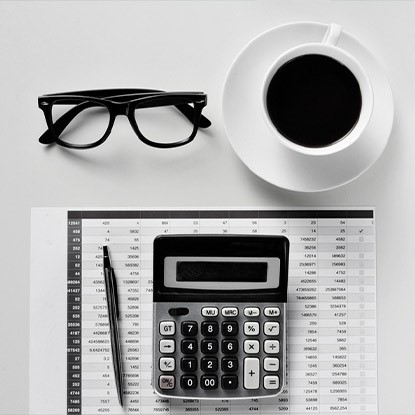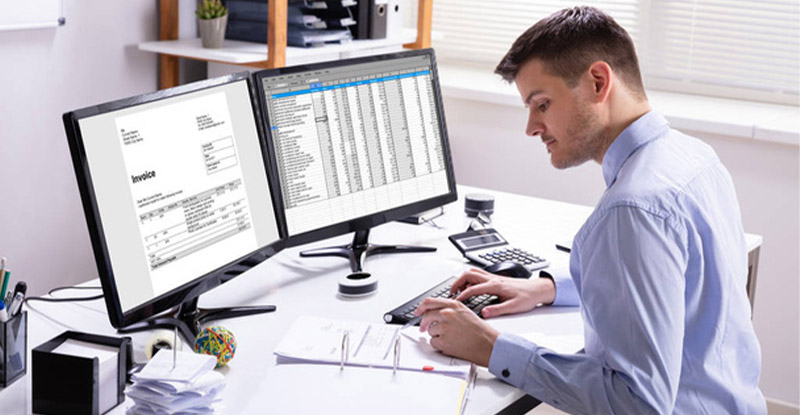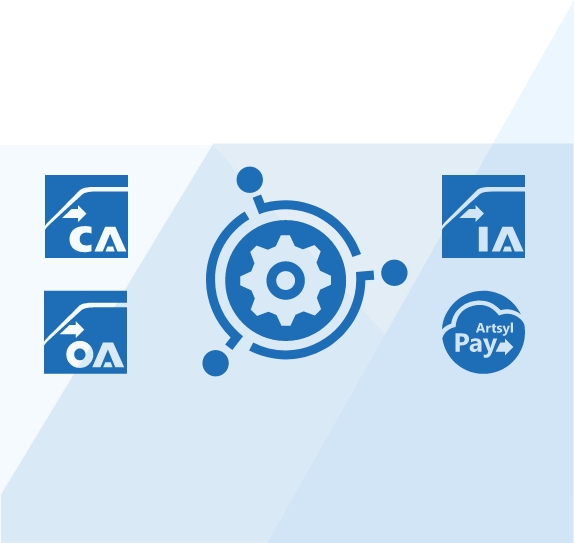When it comes to freelancing or running a small business, the final invoice is a crucial part of the payment process. A final invoice is the last bill sent to a client after completing a project, detailing all the work done and the total amount they owe you.
An accurate and professional final invoice is mandatory because it ensures that you get paid in full and on time. In this blog post, we will guide you through everything you need to know about creating a final invoice.
Tired of endless paperwork and manual errors that slow down your invoicing process? Take control now with Artsyl InvoiceAction! Our automation tools will revolutionize your final invoicing—so you can focus on what really matters. Click here to experience a new era of invoicing efficiency!
Book a demo now
What is the Final Invoice Definition?
A «final invoice» is the last invoice that a supplier or service provider sends to a client, signifying the completion of a project, service, or contractual agreement. Unlike interim invoices, which are issued periodically to cover ongoing costs and facilitate cash flow, a final invoice provides a comprehensive summary of all services rendered, goods supplied, and costs incurred.
The final invoice typically includes the balance due for the entire project or service, minus any initial deposits, interim payments, or credits already applied.
According to Investopedia, an invoice is a «commercial document that itemizes and records a transaction between a buyer and a seller.» In the context of a final invoice, it functions as a conclusive statement that communicates to the client that the contract or project has reached its conclusion and no further billing will occur, unless additional work is requested and agreed upon.
Isn’t it time you said goodbye to the headaches of manual sales order processing? With Artsyl OrderAction, order management is a breeze. Automate your workflow today to ensure accuracy, save time, and get paid faster. Discover how by scheduling a free demo!
Book a demo now
Final Invoice Checklist
Most often, the final invoice contains several key elements. Here’s your final invoice checklist:
- Invoice Number: For tracking and record-keeping purposes.
- Supplier and Client Details: Business names, addresses, and contact information.
- Description of Services or Goods: A detailed list of what has been provided, often broken down into line items.
- Dates: The period during which the services were rendered or goods were supplied.
- Totals: Including subtotals, taxes, and the final amount due.
- Payment Terms: Information about the payment methods accepted and the due date for the final payment.
- Additional Notes: Any disclaimers, legal information, or additional clauses agreed upon.
It is essential for businesses to issue final invoices that are clear, accurate, and complete to ensure timely payment and minimize disputes.
The issuance of a final invoice also often triggers the closeout processes for accounting and project management, making it an important administrative tool.
You’ve mastered your business; now master your financial processes. Artsyl docAlpha makes creating, managing, and automating your financial documentation effortless. Don’t get left behind—join the automation revolution today and elevate your business operations!
Book a demo now
How to Create a Final Invoice
Given its importance in business transactions, best practices recommend that both parties review the final invoice carefully to ensure its accuracy and completeness before processing the final payment.
Failure to adequately detail or clarify any items in the final invoice could lead to delays in payment, financial discrepancies, or even legal complications. Here are the steps to follow when creating a final invoice:
Step 1: Choose a template
The first step in creating a professional final invoice is to choose a template. You can find several templates online that offer different designs and layouts to choose from. It’s important to select a template that is simple, clear, and easy to read. Your final invoice should include your logo, contact information, the client’s contact information, and the total amount due.
Invoice Automation Software
Related Videos
Step 2: Confirm the details
Before creating a final invoice, make sure you have confirmed all the details with the client. This means verifying the project scope, hours worked, or any extra expenses incurred during the project. If there are any discrepancies, make sure to address them before creating the final invoice.
Step 3: Breakdown the costs
It’s important to provide a clear and itemized list of all the work done and the corresponding costs. This means breaking down your fees, hourly rate, and any additional expenses. Make sure to include a grand total at the bottom of the invoice, so the client knows the exact amount they owe.
Step 4: Set payment terms and due date
Your final invoice should clearly indicate when payment is due, how it should be paid, and what the client can expect in case of any payment delays or disputes. Specify your payment terms and the acceptable payment methods you prefer, such as PayPal, bank transfer, or cheque.
Step 5: Follow-up on payment
Once you have sent the final invoice, it’s essential to follow up with the client if payment is not received within the specified time frame. A friendly reminder email or phone call can be an effective way to ensure you get paid promptly and professionally.
Why settle for outdated invoicing methods when you can leap into the future? Artsyl InvoiceAction is your key to modern, automated final invoicing that frees you from administrative shackles. Take the leap—start your free trial and experience the future, today!
Book a demo now
What’s the Difference Between Standard and Final Invoice?
The decision to issue a standard invoice or a final invoice largely depends on the nature of the business transaction, the agreed-upon payment terms, and the lifecycle of the service or project. Here are some scenarios in which each type of invoice is commonly used:
Standard Invoice
- Recurring Services: If you are engaged in an ongoing business relationship where services are provided on a regular basis (monthly, quarterly, etc.), standard invoices are typically issued for each billing cycle.
- Milestone Payments: For long-term projects, standard invoices can be issued when certain milestones are reached, based on a prearranged payment schedule.
- Retail Transactions: In a standard retail setting, standard invoices are often issued immediately after the point of sale.
- Undefined Scope: If the scope of work or the duration of service provision is not clearly defined or agreed upon, standard invoices can be sent periodically to account for ongoing expenses and labor.
Final Invoice
- Project Completion: A final invoice is usually issued once all aspects of a project are completed and both parties are satisfied with the work. This signals the end of the contract or engagement.
- Final Payment: If your project involves a series of payments, the final invoice is used to reconcile all previous payments and charges, resulting in a final amount due.
- Closing Accounts: When terminating a long-term business relationship or subscription service, a final invoice is issued to mark the formal end of the financial dealings between both parties.
- Comprehensive Summary: If the client or the nature of the business prefers a single, comprehensive billing statement at the end of a project, a final invoice is appropriate.
When choosing which invoice to send, standard or final invoice, always consult the terms of your contract or agreement. It may specify when and how invoices should be issued. Standard invoices can facilitate better cash flow, especially for long-term projects, whereas final invoices might suit short-term or one-off projects.
However, some businesses prefer final invoices to minimize administrative tasks, while others use standard invoices to regularly update their accounting records.
In terms of industry practices, the American Institute of Certified Public Accountants (AICPA) provides guidelines on when to use different types of invoices, emphasizing the importance of clear, timely, and accurate invoicing for effective financial management.
Choosing between a standard and final invoice depends on multiple factors, including the nature of your work, client preferences, and your own administrative needs. Understanding these considerations can help you decide which type of invoice is most appropriate for each business scenario.
Transform your order management from a stressful chore to a streamlined joy with Artsyl OrderAction. Our sophisticated sales order management tool take care of the complexities, so you can celebrate the completion of every project. Click to find out how we make order management fast, flawless, and fun!
Book a demo now
Final Thoughts: Optimizing Your Final Invoice Management
Creating a final invoice might seem like a daunting task, but it’s an essential step in receiving payment for your work. By carefully selecting a template, confirming all the details, breaking down the costs, setting payment terms, and following up on payment, you can create a professional final invoice that ensures you get paid in full and on time.
Remember, the key to creating a successful final invoice is to be clear, concise and timely. With a little preparation and attention to detail, you can create a final invoice that satisfies both you and your client.

Stressed over managing your financial processes?
With Artsyl docAlpha, you can automate your way to a stress-free financial documentation experience. From invoice creation to payment reconciliation, we’ve got you covered. Discover how you can relax and enjoy peace of mind—book a consultation today!
FAQ
What is a Final Invoice?
A final invoice is a billing statement sent by a supplier or service provider to a client, indicating the completion of a project, contract, or service. It serves as a comprehensive summary of all services rendered, goods supplied, and costs incurred, often reconciling all previous payments, deposits, and interim invoices.
When Should I Issue a Final Invoice?
Final invoices are generally issued upon the completion of a project or at the end of a contractual agreement. This could vary depending on the industry, client preferences, and the terms specified in your contract.
What Should a Final Invoice Include?
A standard final invoice should include elements like the invoice number, supplier and client details, a detailed description of goods and services, dates of service, totals (including subtotals, taxes, and the final amount due), payment terms, and any additional notes or clauses.
How Does a Final Invoice Differ from a Standard Invoice?
While a standard invoice can be one of many issued over the course of a project or contractual relationship, a final invoice signifies the end of billing for that specific project or contract. A final invoice often includes a reconciliation of all previous billing and payments.
Is a Final Invoice Legally Binding?
Yes, a final invoice serves as a legally binding document that outlines the agreed-upon costs for services or goods provided. It is important for both parties to review the final invoice carefully to ensure it accurately reflects the scope and cost of work.
How Do I Make Sure My Final Invoice Gets Paid?
Ensure that your final invoice is accurate, complete, and issued in a timely manner. Explicitly state the due date and accepted methods of payment. Following up with the client shortly after sending the invoice can also help facilitate prompt payment.
What Happens if a Final Invoice Is Not Paid?
Non-payment of a final invoice can result in legal action or the initiation of debt collection processes. The specific actions that may be taken depend on the terms of the contract and local or national regulations governing commercial transactions.
Do I Need to Keep a Copy of the Final Invoice?
Yes, maintaining a copy of all invoices, including final ones, is crucial for accurate record-keeping and can be important for tax purposes.The length of time for keeping business records depends on your jurisdiction.
Can a Final Invoice Be Amended?
Amendments to a final invoice are generally not recommended unless there is an error or oversight, and both parties agree to the change. Any amendments should be documented and a revised final invoice should be issued.
Is a Final Invoice the Same as a Receipt?
No, a final invoice is a request for payment, while a receipt is an acknowledgment of payment received. A receipt is usually issued after the final invoice has been settled.
Understanding the nuances of final invoices can help both businesses and clients manage the financial aspects of their relationship more effectively. Given their importance in signaling the end of a project or contract, final invoices require careful attention to detail to ensure accuracy and completeness.


 The Basics of an Invoice: The Standard Invoice
The Basics of an Invoice: The Standard Invoice Your Guide to Commercial Invoices
Your Guide to Commercial Invoices Interim Invoice: What Is It?
Interim Invoice: What Is It? Self-Billing Invoice: What Is It?
Self-Billing Invoice: What Is It? Supplier Invoice Management Software
Supplier Invoice Management Software How to Build an Automated Invoice Processing Workflow
How to Build an Automated Invoice Processing Workflow
